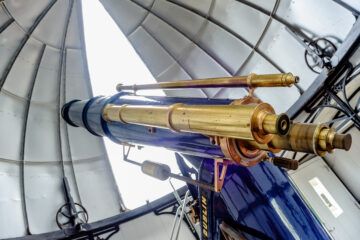MARVELLOUS MAY: SUNNIEST ON RECORD, MUCH WARMER, DRIER THAN AVERAGE. SUNNIEST AND WARMEST SPRING ON RECORD AND DRIER THAN AVERAGE
Armagh Observatory, 6th June 2025: Armagh Observatory reports that May 2025, with 285.4 hours of strong sunshine, was the sunniest May on record at Armagh. Also, following the record-breaking warm May 2024 (average temperature approximately 13.9 C) and the earlier historic record May 1809 (13.8 C), this May, with a mean temperature of approximately 13.2 C, was much warmer than average, the equal third warmest May on record at Armagh. The month was also drier than average, with total precipitation less than two-thirds the average at Armagh.
Taking the three months March, April, and May together, spring 2025 was the sunniest (617.1 hours of strong sunshine) and the warmest (average temperature 10.7 C) at Armagh on record, and also drier than average.
With an average temperature of 13.2 C this May was the third warmest May on record at Armagh, shared with May 1848, May 2017, and May 2008. However, although the average maximum temperature each day was boosted by strong sunshine, there were no exceptionally warm days. The three warmest days, that is, those with the highest maximum temperatures, were the 21st (23.2 C), the 18th (23.0 C), and the 16th (22.7 C). The 30th of April (maximum temperature 23.4 C) remains the warmest day of the year so far at Armagh and promises to hold this position up to at least the middle of June.
The monthly average of the daily temperature maxima this May was 19.0 C. This is approximately 3.7 C warmer than the 176-year (1844-2020) long-term average daily maximum temperature for May at Armagh (15.3 C) and 3.1 C warmer than the corresponding (1991-2020) 30-year average. This was the highest average daily maximum temperature for May at Armagh for 177 years, that is, since the record-breaking May 1848 with a corresponding average of approximately 19.2 C.
For comparison, the average of the daily temperature minima was 7.36 C. This is approximately 1.08 C warmer than the corresponding 176-year (1844-2020) long-term average for May at Armagh (6.28 C) and 0.36 C warmer than the most recent (1991-2020) 30-year average (7.00 C).
These differences highlight the effects of largely clear skies this May, namely raising daytime temperatures and lowering those at night. Conversely, although the previous May 2024 reported a record high average temperature for the month (13.9 C), that month was duller than average with the high average temperature more strongly influenced by warm nights than hot days. Such differences show the importance of the poorly understood phenomenon of cloudiness in determining a month’s average temperature.
The three coolest days (lowest daily maximum temperatures) were the 4th (14.2 C), the 26th (14.8 C), and the 25th and 27th (both 15.1 C). The warmest night (highest minimum air temperature) was the 30th (13.5 C), followed by the 31st (13.1 C) and the 24th (12.9 C). The coolest night (lowest minimum air temperature) was the 5th (1.0 C), followed by the 6th (2.4 C) and the 9th (3.7 C).
A further consequence of relatively clear skies this May is that there was a relatively large number of nights with ground frost, that is, nights when the grass minimum temperature fell to less than or equal to zero degrees Celsius. The three hardest ground frosts occurred on the 5th, 9th, and 8th of May, with respective grass-minimum temperatures of -6.2 C, -2.9 C and -2.4 C. There were no air frosts, promising this year a good fruit crop.
Total precipitation this May was 38.25 mm (1.51 inches) including one trace value, that is, 38.2 mm if trace values are ignored. This is approximately 65% of the May average at Armagh (approximately 58 mm) and continues an interesting result that most recent Mays at Armagh, now eight of the last ten, have been drier than average. The wettest day was the 28th with 7.4 mm of precipitation, followed by the 11th with 5.9 mm and the 24th with 5.7 mm.
The observer noted the first swallow of the season on the 1st of May and the first swifts on the 7th.
This May was dominated by higher-than-average atmospheric pressure, the average 09:00 GMT pressure at Armagh (reduced to mean sea level) being approximately 1020.1 mbar. This is 4.7 mbar higher than the 170-year (1851-2020) long-term average 09:00 GMT May pressure at Armagh (1015.4 mbar) and 4.1 mbar higher than the most recent (1991-2020) 30-year May average (1016.0 mbar). There were no gales this month.
Thunder was heard during the evening of the 20th when localised thundery downpours, some with large hailstones, were reported from neighbouring areas around Armagh. At the Observatory, however, only raindrops were reported, and no precipitation recorded. A double rainbow was observed on the evening of the 24th.
May 2025 reported a record amount of strong sunshine, namely 285.4 hours, which is nearly 62% more than the 140-year (1881-2020) long-term May average at Armagh (176.4 hours) and 60% more than the most recent (1991-2020) 30-year average (178.8 hours). The four sunniest Mays at Armagh are now May 2025 (285.4 hours), May 1901 (254.1 hours), May 1935 (251.6 hours), and May 2017 (250.2 hours). May 2025 is now also the sunniest month at Armagh, the four following sunniest months being June 1887 (263.7 hours), June 1940 (256.0 hours), May 1901 (254.1 hours), and June 1949 (252.9 hours). The sunniest day was the 13th with 14.9 hours of strong sunshine, followed by 14.3 hours on the 14th, and 14.2 hours on both the 15th and 17th.
Taking the three months March, April and May together, the meteorological spring 2025 was drier than average and both the sunniest and the warmest spring on record at Armagh. These records of strong sunshine and temperature refer to observations at Armagh that began in 1880 and 1795 respectively.
The mean spring temperature was an exceptionally warm 10.74 C. This is 2.62 C warmer than the 225-year (1795-2020) average spring temperature at Armagh (8.12 C) and 1.75 C warmer than the most recent (1991-2020) 30-year spring average (8.99 C). The five warmest springs at Armagh are now 2025 (10.7 C), 2017 and 2024 (both 10.2 C), and 1945 and 2011 (both 10.0 C).
Total spring precipitation was 120.9 mm including 6 trace values, that is, 120.6 mm if trace values are ignored. This is approximately 72% of the 183-year (1838-2020) long-term average spring precipitation at Armagh (167.0 mm) and nearly 70% of the most recent (1991-2020) 30-year average (173.8 mm). Rainfall totals at Armagh vary significantly from month to month and from year to year, but on average show very little change over nearly two hundred years.
Each of the meteorological spring months (March, April, and May) were sunnier or much sunnier than average. This led to spring 2025 being exceptionally sunny. The 617.1 hours of strong sunshine set a new record for spring sunshine at Armagh, approximately 45% more than the 140-year (1881-2020) long-term spring average at Armagh (424.4 hours) and 43% more than the most recent (1991-2020) 30-year spring average (431.6 hours). The four sunniest springs at Armagh are now spring 2025 (617.1 hours), spring 2020 (567.4 hours), spring 2007 (554.3 hours), and spring 2008 (547.6 hours).
These data refer to observations at Armagh Observatory, which has been recording the weather at Armagh since 1795.
For further information, please contact:
Professor Mark E. Bailey
Emeritus Director of Armagh Observatory
Armagh Observatory and Planetarium
College Hill
Armagh
BT61 9DG
Tel: 028-3752-2928
E-mail: mark.bailey@armagh.ac.uk



0 Comments